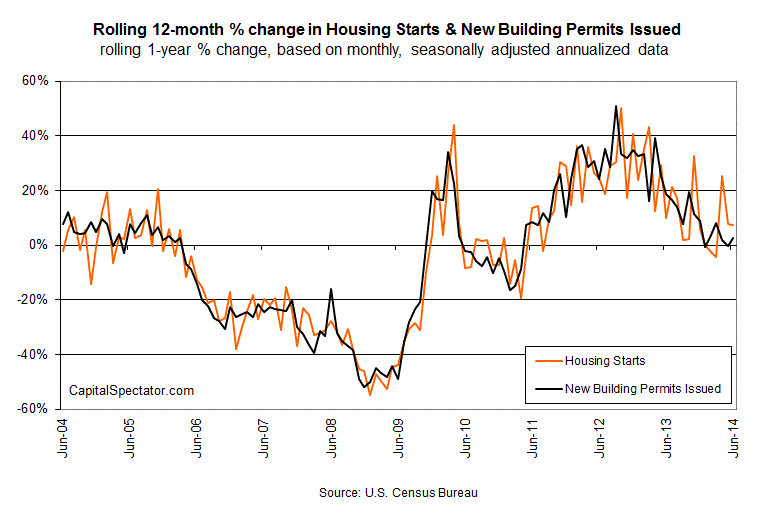Housing starts were surprisingly weak in June, the Census Bureau reports. The consensus forecast was looking for a modest gain to a 1.026 million annualized rate. Instead, the actual number dipped to 893,000—the lowest since last September. Newly issued permits for housing construction suffered a similar setback. In fact, housing has been a weak spot in the economy this year and today’s release doesn’t tell us otherwise. But the outlook for the sector isn’t as dark as it appears when focusing on the latest monthly changes. As we’ll see, the annual growth for starts and permits leaves more room for optimism. Not a lot, but there’s a decent if still unproven case for thinking that the housing sector is stabilizing, albeit at a substantially slower rate of growth vs. 2012 and early 2013.
Even so, it’s clear that housing’s recovery has decelerated substantially this year, based on the year-over-year changes in starts and permits. Last month, for instance, we wondered: “Where’s that spring rebound?” for home construction. But perhaps its time to distinguish between a correction (or bear market) for housing and slow growth. As of June, new residential construction was higher by 7.5% vs. a year earlier; permits are up 2.7%. The 20%-to-40% year-over-year gains are long gone, but construction activity seems to be holding steady at a low burn.
The future may tell us otherwise, of course, and given the higher degree of uncertainty it’s prudent to ask if the housing sector is caught in a downward spiral or just transitioning to a slow but perhaps sustainable rate of growth. The possibility for a “dull housing market” has been a topical subject on these pages this year (see here, for instance), and one can reasonably argue that we’re seeing exactly that. Surprising? Not exactly. The stellar increases in starts of recent vintage were never long for this world. Once the housing recovery moved into middle age after righting itself in the wake of collapsing in 2006-2009, lackluster growth was fate, at least by the standards of the early post-crash revival phase.
True, it’s still unclear if housing’s downshift is “normal” and marks a return to a steady but uneventful period of growth. On that point, note that through 2005 or so, the current year-over-year gains of roughly 10% in starts and permits were routine.
The burning question now is whether the modest annual rise through June will roll on? The odds still favor answering “yes.” Why? Mainly because the rest of the economy continues to reflect moderate growth on a persistent basis, starting with the labor market. Private payrolls continue to rise at a roughly 2% rate on a year-over-year basis. That’s a key factor, as the chairman of the National Association of Home Builders (NAHB) explained yesterday:
An improving job market goes hand-in-hand with a rise in builder confidence. As employment increases and those with jobs feel more secure about their own economic situation, they are more likely to feel comfortable about buying a home.
The mood in the homebuilding industry, by the way, has perked up in July, according to NAHB. The group’s housing market index, which measures the mood among homebuilders, jumped to 53 this month—the first increase since January over the neutral 50 mark that separates growth from contraction. That’s a clue for projecting that the starts report for July (scheduled for release next month) will show some improvement over today’s June data.
As for the all-important labor market, it’s certainly encouraging that this morning’s weekly update on jobless claims—a relatively reliable leading indicator for employment and the economy overall—brought another round of good news. New filings for unemployment benefits fell to 302,000 on a seasonally adjusted basis last week—just slightly higher than the seven-year low that was recorded two months ago (for the week through May 10). That’s a robust signal for expecting that the moderately faster monthly pace in job creation this year will roll on.
The soft housing numbers would be worrisome if the general macro trend for the US was deteriorating. But there are minimal signs of big-picture stress when looking across a broad set of data. The argument that the economy’s poised for dramatically stronger growth still looks unpersuasive, but projecting moderate growth remains a good bet. In turn, that’s a reason to think that the slow growth for housing will persist. A continuous run of negative year-over-year comparisons for starts and permits would tell us otherwise, but for the moment those dark signals are MIA.

Are we not seeing the effects of a slow recovery from a severe balance-sheet recession, combined with the aging and retirement of the boomer generation? This second factor has gone largely unremarked, but as someone born before the boomers, I have seen it all my life and I’ve learned to expect it. The boomers powered our economy for decades, now they are slowing down. The effect of that slowdown is evident throughout our economy as the difference between the growth we have come to expect and the growth we must learn to expect as boomers no longer provide that extra push.
Pingback: Is The Soft Housing Starts Data For June A Warning Or A Sign Of A Maturing Recovery? – The Capital Spectator | Marty Investor